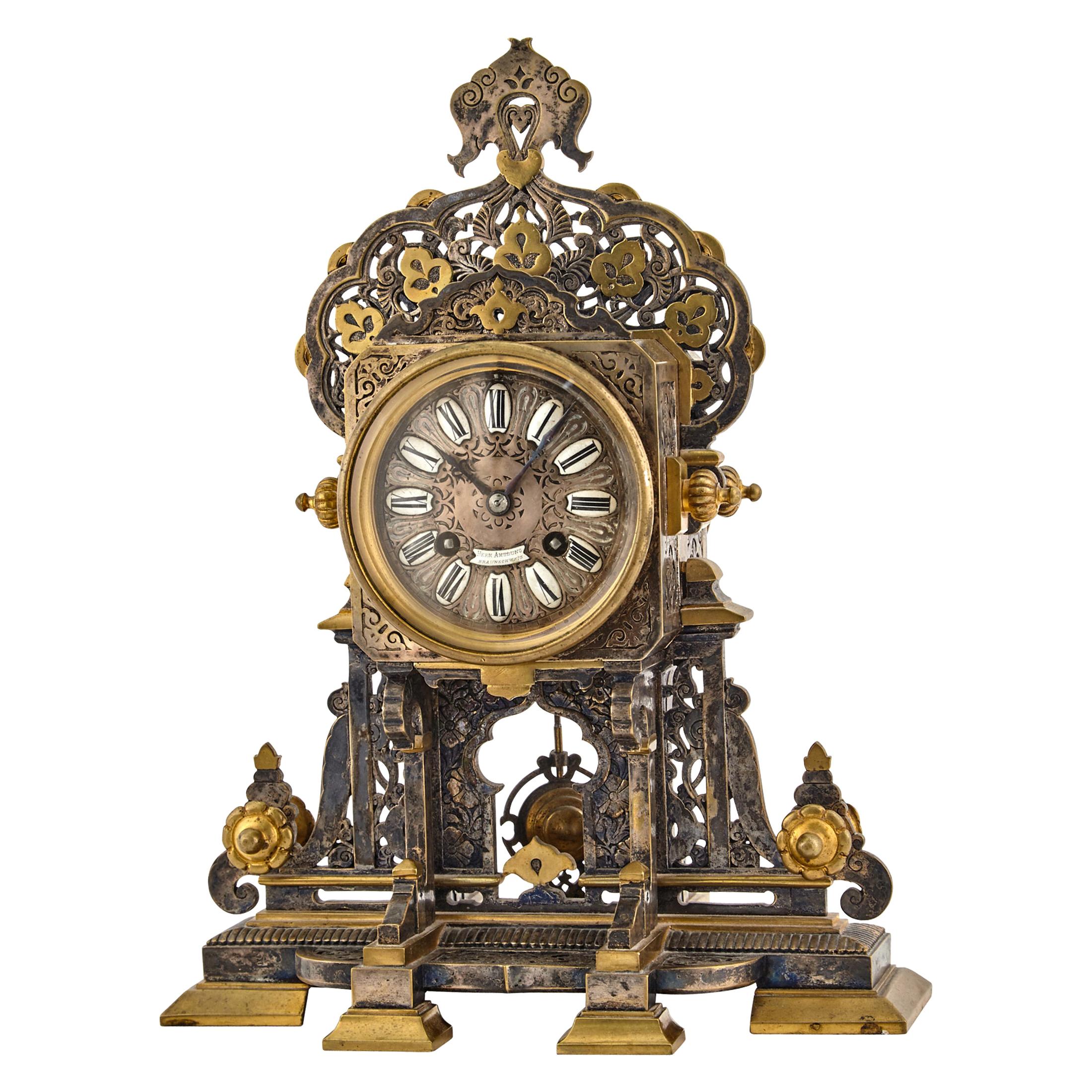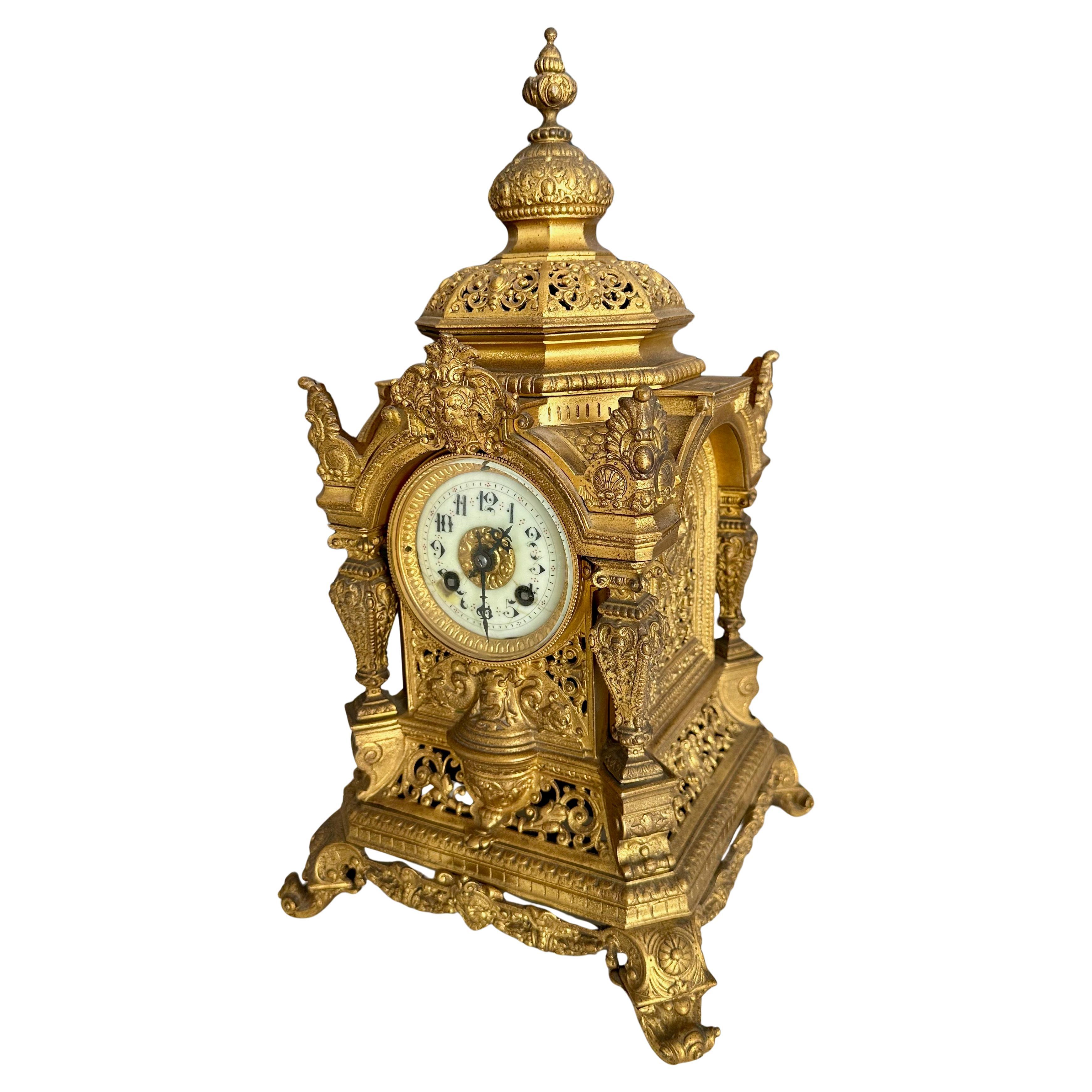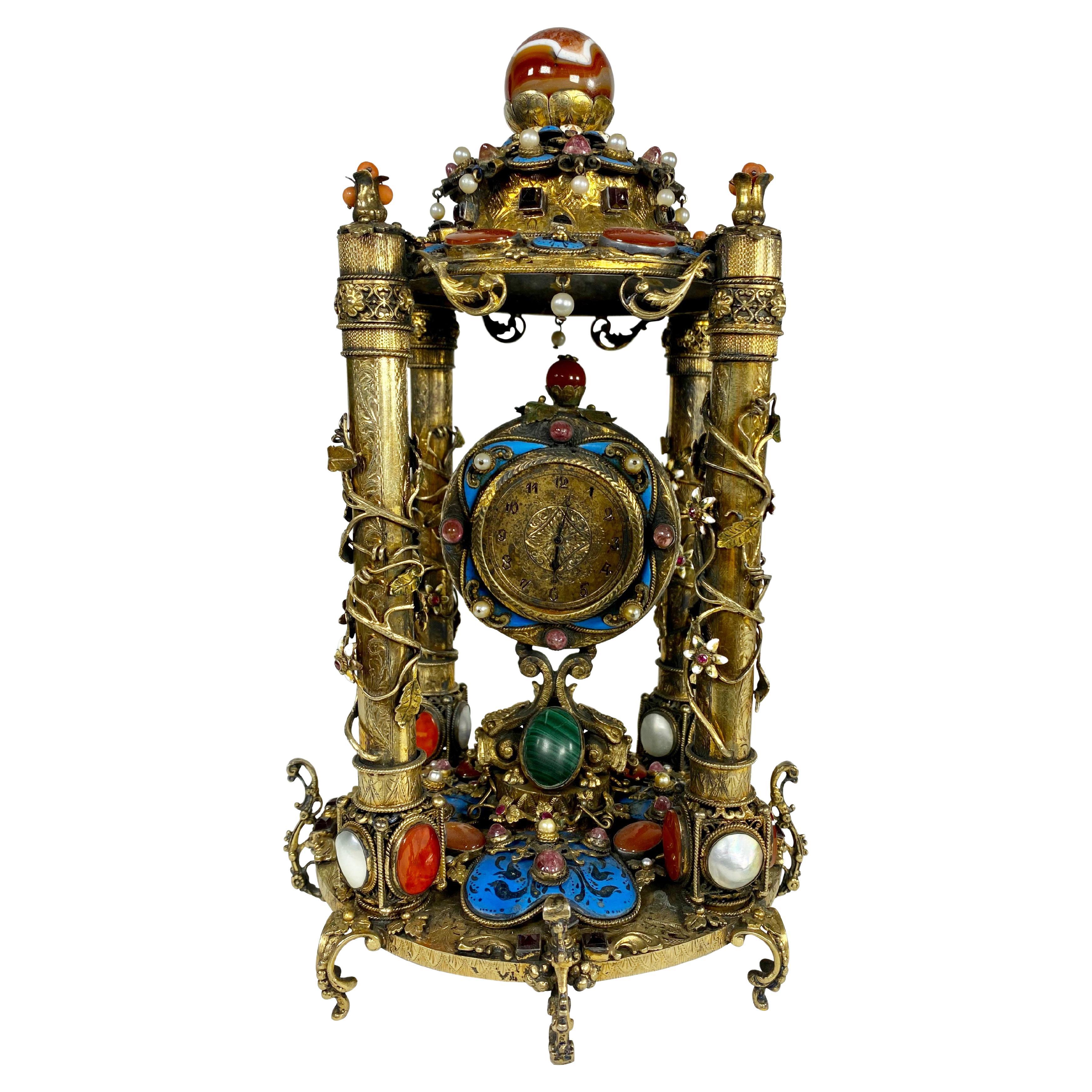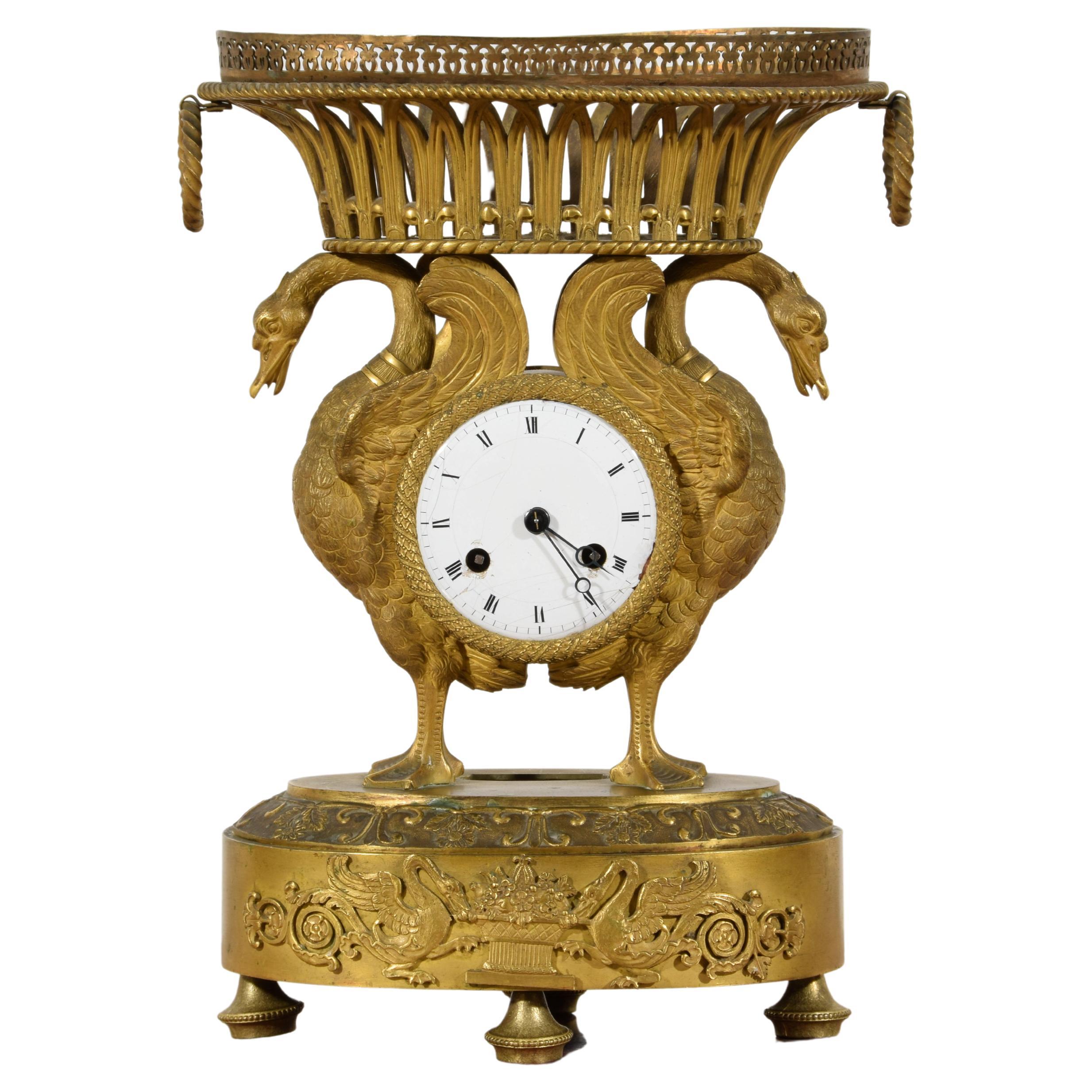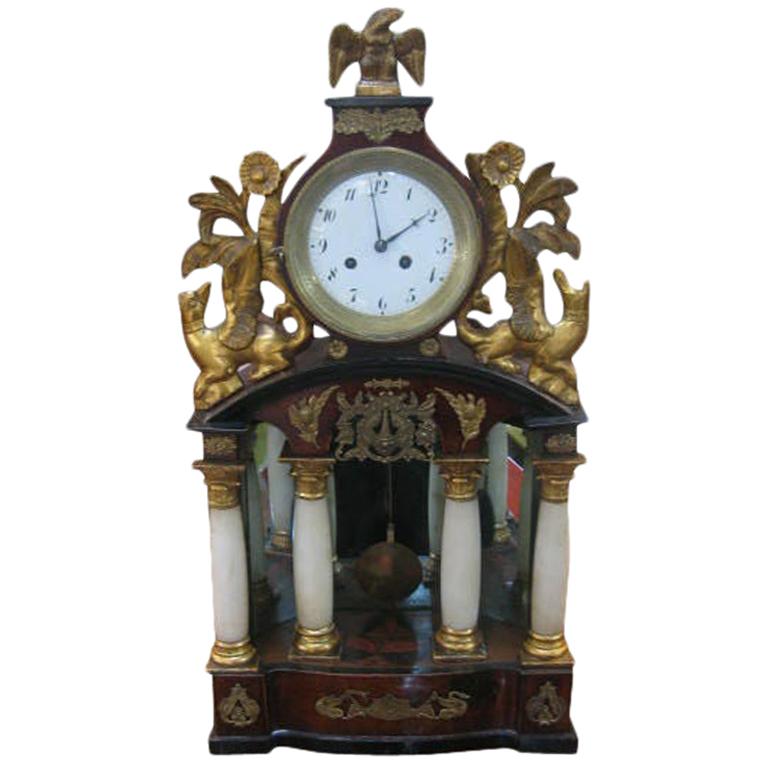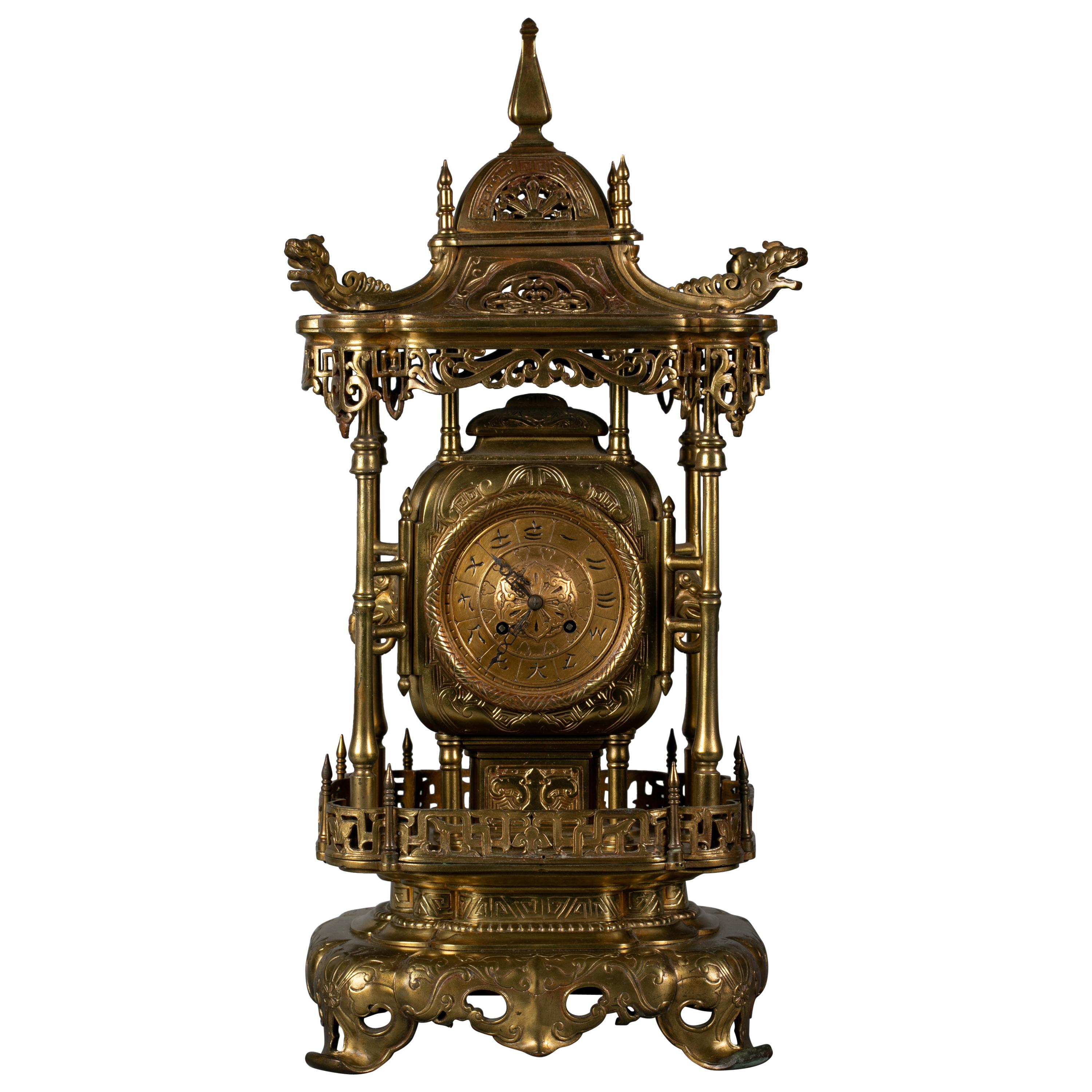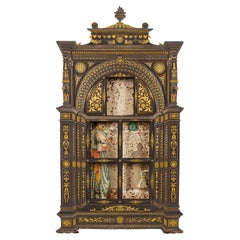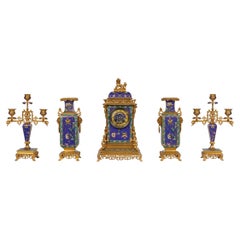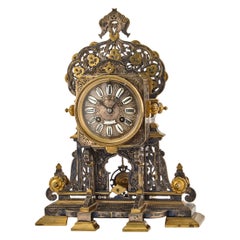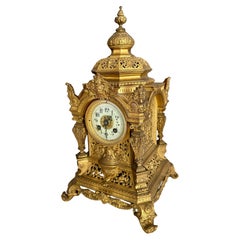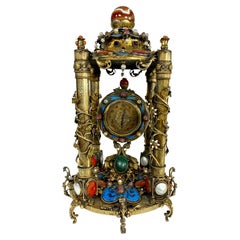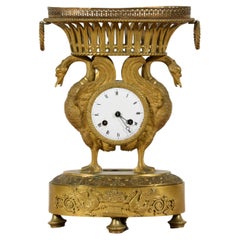Items Similar to Rare & Important Spanish Damascene, Iron, Steel, Gold Inlaid Clock, Eibar, Spain
Video Loading
Want more images or videos?
Request additional images or videos from the seller
1 of 22
Rare & Important Spanish Damascene, Iron, Steel, Gold Inlaid Clock, Eibar, Spain
$185,000
£139,694.99
€160,983.18
CA$261,113.63
A$287,871.85
CHF 150,605.24
MX$3,531,652.59
NOK 1,895,821.73
SEK 1,772,893.11
DKK 1,202,226.57
About the Item
A highly rare and important Spanish damascene, "Egyptian Revival" iron, steel, gold, and silver inlaid clock,
circa 1900
Exceptional quality, damascened in gold and silver inlay.
Measures: 10" high x 16" wide x 9" deep.
Definitely made by one of Placido Zuloaga's disciples – such as José Vicente Iriondo or Tomás Guisasola y Guisasola, Spain, Eibar and retailed by Beristain of Barcelona, Spain.
José Vicente Iriondo, known affectionately in Eibar by the nickname ‘Mantxón’, and his brother-in-law Tomás Guisasola y Guisasola, were disciples of Plácido Zuloaga, and towards the turn of the century they became partners.
Because of the number of specialists involved in this clocks manufacture, its great size, and the excellence of its exquisite quality, one may conjecture that it was a major commission coming from a workshop manned by some of the earlier disciples of Plácido Zuloaga.
Furthermore Beristain of Barcelona are recorded to have retailed guns and other damascened works of art in the early 20th century.
Born into a family of Spanish Royal Armourers, Plácido Zuloaga (d. 1910) went on to become one of the greatest masters of the decorative art of damascening, praised in his day as 'a second Benvenuto Cellini'. His first recognition as an artist came in 1855 when, together with his father Eusebio, he inspired the following comments for work shown at the Paris Exposition Universelle: 'One cannot praise too highly the arms and other metal objects presented by the Sres. Zuloaga, father and son; iron-chiselling, damascene, etching and repoussé never had interpreters of such obvious and varied talent' (Anon. Visite à l'Exposition Universelle de Paris, Paris, 1855, p. 121).
In 1859, Plácido took over the management of Eusebio's manufactory at Eibar in the northern Basque province of Guipúzcoa, and what had principally been a gun-making factory for the previous two generations was gradually transformed under his supervision into one for forging and damascening art objects. The switch reflected not only Plácido's personal artistic interests, but also the changing face of a gun-making industry, which by the middle of the century was becoming increasingly machine-driven. Additionally, Zuloaga sought to capitalise on the midcentury fashion for iron decoration, which had its roots in architecture (for example, the pavilions constructed for the 1851 Crystal Palace Exhibition), but which was most prevalent in the form of domestic cast iron furnishings.
On the death of his father in 1856, Eusebio Zuloaga was promoted to the position of Chief Armourer to Isabel II and her consort king, and was given the title of Huntsman to the Royal Family. For the next twelve years, therefore, the firm of Zuloaga was kept busy not only supplying weaponry and armour, but also sumptuous table objects ordered by the monarchy, either for gifts or for their own private use. The latter included a gold and silver-damascened iron inkstand supplied to Isabel II in 1860 (illustrated Lavin, p. 52, fig. 10), and a magnificent table-clock ordered by the queen mother, Marìa Cristina, for presentation to Napoleon III (op. cit., p. 55, fig. 11). However, the fall of Isabel II's government in 1868 not only brought the Royal patronage enjoyed by the Zuloagas over the previous decade to an abrupt end, it left the firm with considerable monetary loss, as 30,000 francs in salary and materials for work sent to the king would now not be reimbursed. Fortunately for Plácido Zuloaga, a new patron, less prone to the precariousness of 19th century European royalty, arrived to replace the Borbóns and became his most important client for the next two decades.
Plácido Zuloaga is believed to have met Alfred Morrison during his visit to London for the International Exhibition of 1862. The son of a wealthy textile magnate, Morrison had inherited the estate of Fonthill, Wiltshire, on the death of his father in 1857. Soon after, he engaged Owen Jones, the celebrated architect, to redesign its interior to complement his already extensive collection of modern
objets d'art, commissioned from the most noteworthy European artisans of the day. Jones was an admirer of Islamic, and by extension, Spanish ornamentation, and had even spent some time living in the Alhambra, Granada. These tastes corresponded with those of Morrison, who over the next twenty years was responsible for virtually all of Plácido Zuloaga's major commissions, whether they were intended for Fonthill or for his London home at 16 Carlton House Terrace, acquired in 1865 and decorated by Jones in the same taste. Chief among these commissions were an enormous Renaissance style cassone, executed 1870-1 (sold Christie's, The Remaining Contents of Fonthill House, 1-2 November 1971, lot 9, now in the Khalili collection; see Lavin, cat. 1, pp. 71-81) and a magnificent side-table, completed in 1880 and now in the collection of Her Majesty the Queen (see Lavin, fig. 16, p. 62).
- Similar to:Plácido Zuloaga 1 (Metalworker)
- Dimensions:Height: 10 in (25.4 cm)Width: 16 in (40.64 cm)Depth: 9 in (22.86 cm)
- Style:Egyptian Revival (Of the Period)
- Materials and Techniques:
- Place of Origin:
- Period:
- Date of Manufacture:circa 1900
- Condition:
- Seller Location:Queens, NY
- Reference Number:1stDibs: LU1798213687531
About the Seller
5.0
Vetted Professional Seller
Every seller passes strict standards for authenticity and reliability
Established in 1980
1stDibs seller since 2016
63 sales on 1stDibs
Typical response time: 1 hour
- ShippingRetrieving quote...Shipping from: Queens, NY
- Return Policy
Authenticity Guarantee
In the unlikely event there’s an issue with an item’s authenticity, contact us within 1 year for a full refund. DetailsMoney-Back Guarantee
If your item is not as described, is damaged in transit, or does not arrive, contact us within 7 days for a full refund. Details24-Hour Cancellation
You have a 24-hour grace period in which to reconsider your purchase, with no questions asked.Vetted Professional Sellers
Our world-class sellers must adhere to strict standards for service and quality, maintaining the integrity of our listings.Price-Match Guarantee
If you find that a seller listed the same item for a lower price elsewhere, we’ll match it.Trusted Global Delivery
Our best-in-class carrier network provides specialized shipping options worldwide, including custom delivery.More From This Seller
View AllExquisite French Empire Ormolu and Cut-Crystal Clock, c. 1815
Located in Queens, NY
An exquisite French Empire ormolu and cut-crystal clock, c. 1815, attributed to Baccarat.
Made from the finest quality mercury gilding ormolu, this c...
Category
Antique Early 19th Century French Empire Mantel Clocks
Materials
Crystal, Ormolu
Placido Zuloaga, an Extremely Rare Spanish Gold and Silver Damascened Frame
By Plácido Zuloaga 1
Located in Queens, NY
Placido Zuloaga, An extremely rare Spanish gold and silver damascened window frame, in the Alhambra / Islamic taste, circa 1880.
The interior is lined and fitted with an orientalist artwork throughout.
Signed PZ on the reverse.
Placido Zuloaga was a renowned Spanish metalworker and damascene artist known for his exceptional skills in working with gold and silver and for creating intricate and ornate designs on metal surfaces using a technique called damascening.
One of Zuloaga's works is this rare gold and silver damascened frame that he created in the late 19th century. The frame is decorated with intricate designs in silver and gold, creating a stunning contrast that is characteristic of Zuloaga's work.
The frame is a remarkable example of Zuloaga's artistry and skill, as well as his mastery of the damascening technique. The technique involves inlaying silver or gold wire into the surface of the metal, creating intricate and detailed designs that are both beautiful and durable.
Zuloaga's work was highly sought after during his lifetime and is still highly valued today. His pieces are considered to be some of the finest examples of damascene artistry in the world, and his legacy continues to inspire and influence metalworkers and artists today.
His works are in private collections and in museums worldwide.
Comparative Literature:
James D. Lavin, The Art and Tradition of the Zuloagas, Spanish Damascene...
Category
Antique 19th Century Spanish Islamic Picture Frames
Materials
Steel, Iron
A Monumental and Exceptional French Ormolu and Turquoise Sevres Porcelain Clock
Located in Queens, NY
A Monumental and Exceptional French Ormolu and Turquoise Sevres Porcelain Clock, circa 1875
Immerse yourself in the splendor of 19th-century French artistry with this monumental and...
Category
Antique 19th Century French Napoleon III Mantel Clocks
Materials
Ormolu
An Exceptional French Japonisme Ormolu and Champleve Enamel Five Piece Clock Set
By Edouard Lievre
Located in Queens, NY
An Exceptional French Japonisme Ormolu and Champlevé Enamel Five-Piece Clock Set, In the Manner of Edouard Lièvre, circa 1870, Paris.
This extraordinary French Japonisme clock set, ...
Category
Antique 19th Century French Japonisme Mantel Clocks
Materials
Enamel, Ormolu
Palatial & Rare Napoleon III French Ormolu and Patinated Bronze Clock, Detouche
By C. Detouche
Located in Queens, NY
A Palatial and Extremely Rare Napoleon III French Ormolu and Patinated Bronze Regulateur de Parquet Clock by Louis-Constantin Detouche, Paris, Circa 1850
An exceptional testament to the grandeur and technical mastery of 19th-century French horology, this palatial and extraordinarily rare Napoleon III ormolu and patinated bronze Regulateur de Parquet clock stands as a crowning achievement of the renowned Parisian horologist Louis-Constantin Detouche. Created circa 1850, this monumental timepiece exemplifies the perfect synthesis of artistic opulence and mechanical precision, distinguishing itself as one of the most impressive works from Detouche’s illustrious oeuvre.
At over six feet tall, this clock’s imposing scale and decorative grandeur make it an object of immense historical and aesthetic significance. The case, crafted from the finest French ormolu, features two majestic patinated bronze seated putti, serving as allegorical figures and underscoring the artistic sophistication characteristic of the Second Empire style. The white enamel dial, elegantly signed "C. Detouche/Paris," affirms its prestigious maker, while the movement, meticulously numbered 7064 and bearing the stamps "C. Detouche RUE St. MARTIN" and "C. DETOUCHE 158 R. St MARTIN 160," speaks to the highest standards of 19th-century horological craftsmanship. Further distinguishing this piece is the medaille d’argent stamp, a testament to the numerous accolades and awards bestowed upon Detouche for his innovations in timekeeping.
A Masterpiece of Horological Artistry:
Louis-Constantin Detouche was not merely a clockmaker; he was a visionary whose contributions to horology redefined precision and complexity. This particular regulator clock...
Category
Antique 19th Century French Napoleon III Grandfather Clocks and Longcase...
Materials
Bronze, Ormolu
An Exquisite and Rare French Louis XVI Style Ormolu-Mounted Bloodstone Inkwell
Located in Queens, NY
An Exquisite and Rare French Louis XVI Style Ormolu-Mounted Bloodstone Inkwell, circa 1875.
A truly exceptional and jewel like quality inkwell encrier, made with the finest ormolu, mounted on bloodstone. A true collectors and one of a kind piece.
Revival of the ancient régime in the late 19th century was paramount to the French furniture and bronze casting firms of the Belle Epoque. Imitation in the highest regard and replication of those tastes and styles was prevalent throughout the Paris Faubourg, where the most talented bronziers and ébénistes established their workshops. The present inkwell encrier recalls the late 18th century's obsession with hardstones - a taste expounded above all by the duc d'Aumont and, subsequently Marie-Antoinette. Such hardstone-mounted pieces, reminiscent of Renaissance schatzkammer objects, enjoyed a revived popularity at the end of the 18th century through the impetus of both the marchands-mercier and, more importantly, the hôtel des Menus-Plaisirs, where the duc d'Aumont himself established a workshop in 1770 specializing in the cutting and polishing of precious hardstones.
This exceptional inkwell encrier, sumptuously-mounted with finely chased gilt-bronzes, incorporates a highly-prized material such as bloodstone.
Sometimes called the Sunstone, the meaning of Bloodstone comes entangled in fascinating history. The Ancient Greeks held the Bloodstone as a gem with glorious powers. They referred to it as Heliotrope, which directly translates to Sunstone. It was believed to have heavenly healing powers gifted by the gods and most certainly when it came to healing all things related to the blood. Even as we move forward into the Middle Ages, the Bloodstone takes another mystical story under its wing. It was believed to be formed from Christ's blood. It was said that during the Crucifixion, a few red spots of his blood dripped...
Category
Antique 19th Century French Napoleon III Inkwells
Materials
Bronze, Ormolu
You May Also Like
Important German Gilt and Silvered Bronze Mantel Clock by Braunschweig
Located in New York, NY
The movement stamped 7105 / 7433.
Maker: Herm. Amelung, Braunschweig
Origin: German<
Date: 19th century
Measures: Height 13 3/4 in. x 10 1/2 in.
Category
Antique 19th Century German Mantel Clocks
Materials
Bronze
Antique French Gilt Bronze Architectural Clock by S. Marti
Located in Palm Springs, CA
An original antique 19th C French Renaissance revival cathedral architectural theme mantle clock in solid gilt ormolu bronze (or brass) by S. Marti (stamped H & F Paris).
Clock mech...
Category
Antique Late 19th Century French More Clocks
Materials
Brass, Bronze
A Rare Austro Hungarian Gilt Silver & Jeweled Table Clock, Circa 1900
Located in Los Angeles, CA
A Rare Austro Hungarian Gilt Silver & Jeweled Table Clock, Circa 1900, having semi precious stones throughout including agate, malachite, amethyst, pearl, coral and enamel DIMENSIONS...
Category
Early 20th Century Austrian Table Clocks and Desk Clocks
Materials
Agate, Coral, Silver, Enamel
19th Century, French Chiselled and Gilt Bronze Table Clock
Located in IT
19th century, French chiselled and gilt bronze table clock
This table clock was made of chiselled and gilded bronze in the early 19th centur...
Category
Antique Early 19th Century French Empire Table Clocks and Desk Clocks
Materials
Bronze
19th Century Italian Empire Clock with Parcel-Gilt and Bronze Details
Located in Dallas, TX
Beautifully designed mantel (fireplace) clock with ornate bronze embellishments. Carved and gilded griffins flank the clock face. A gilt eagle is the finial. The beautiful wood case is embellished with painted geometric designs and marble pilasters...
Category
Antique 19th Century Italian Clocks
Materials
Bronze
French Bronze Chinoiserie Clock, circa 1880
Located in New York, NY
French bronze chinoiserie clock, circa 1880.
Category
Antique 1880s French Table Clocks and Desk Clocks
Materials
Bronze
